Physical Address
304 North Cardinal St.
Dorchester Center, MA 02124
These are inflammatory diseases involving sweat glands or pilosebaceous units.
(see Fig. 10.1A–E )
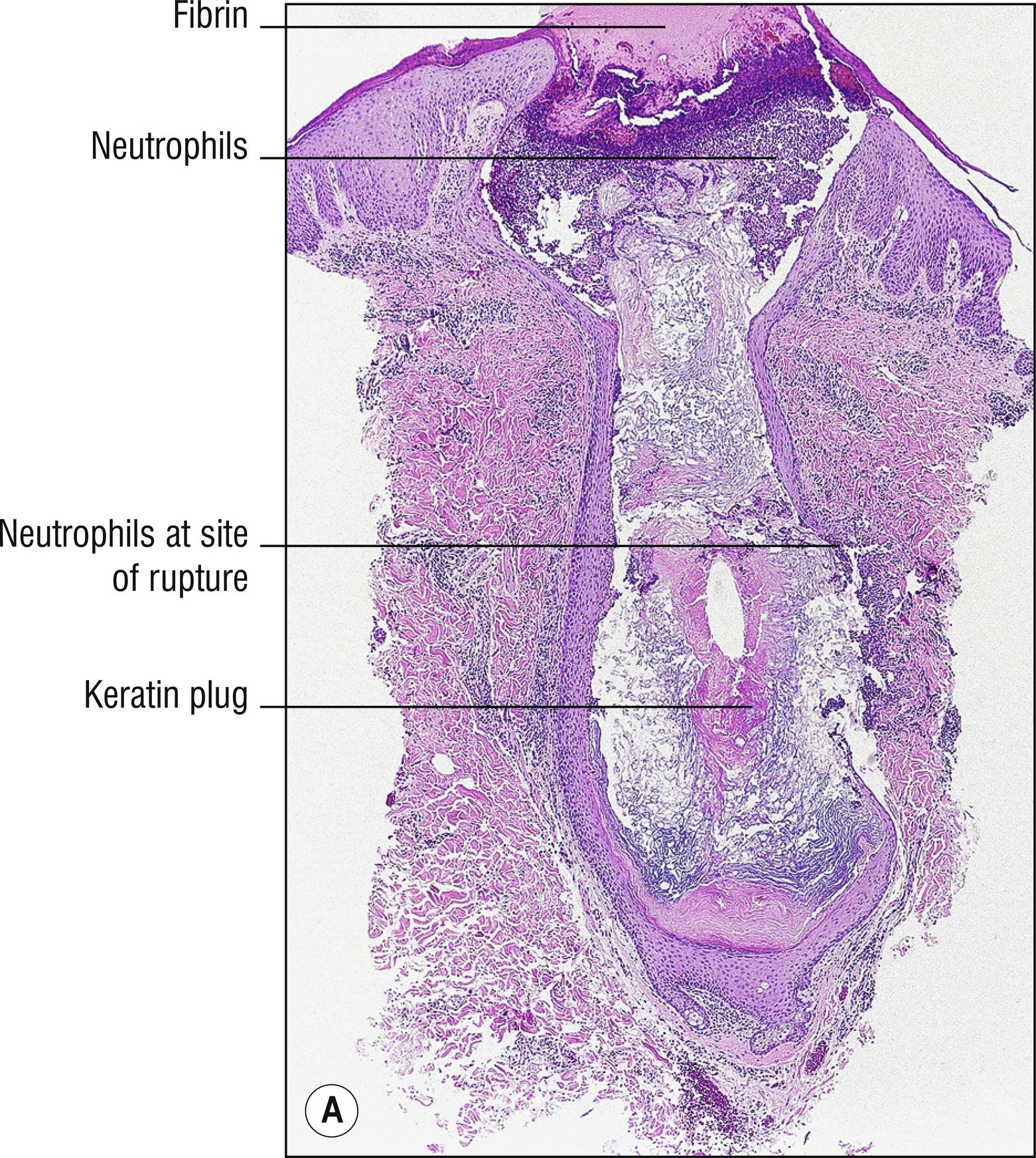
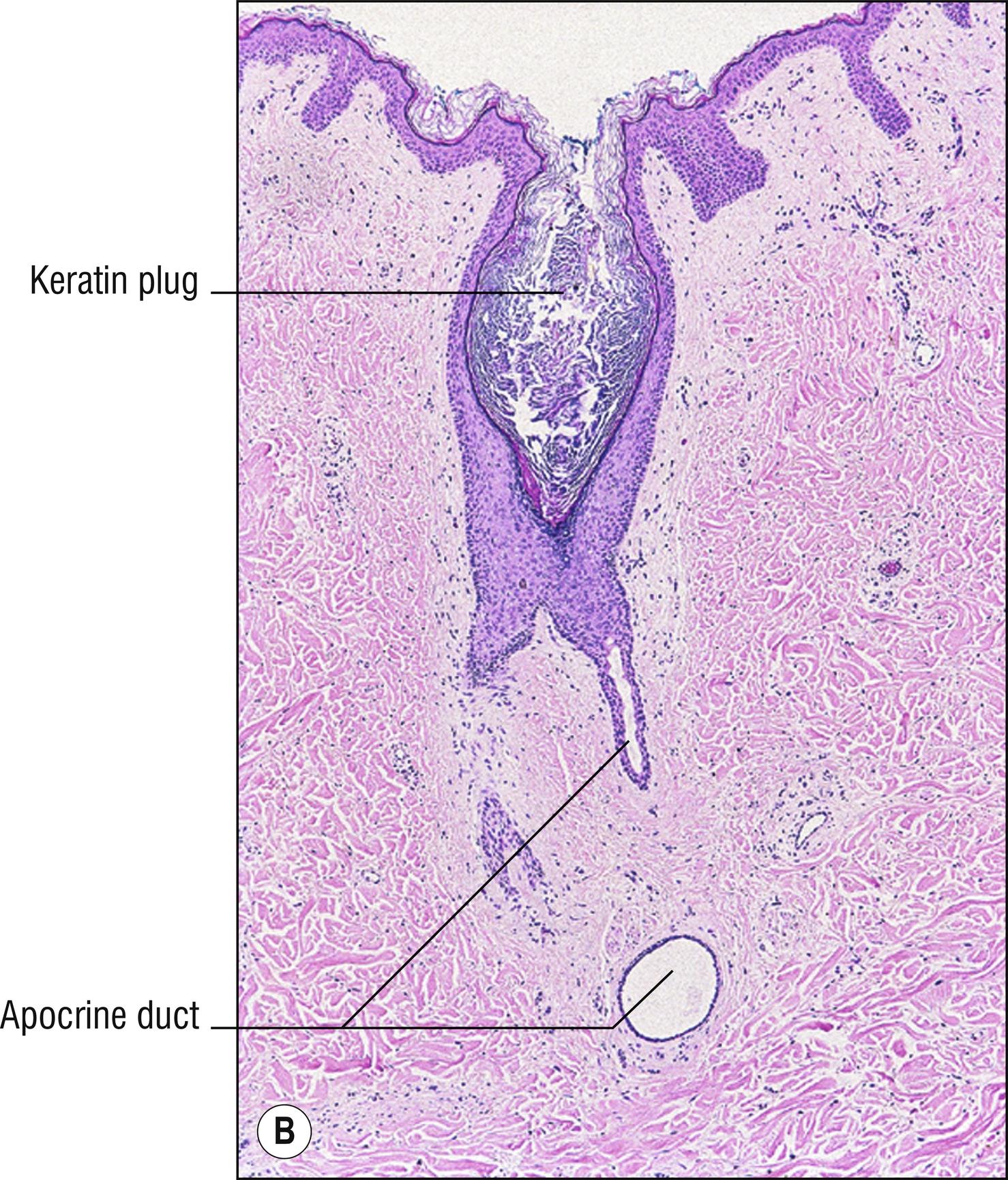
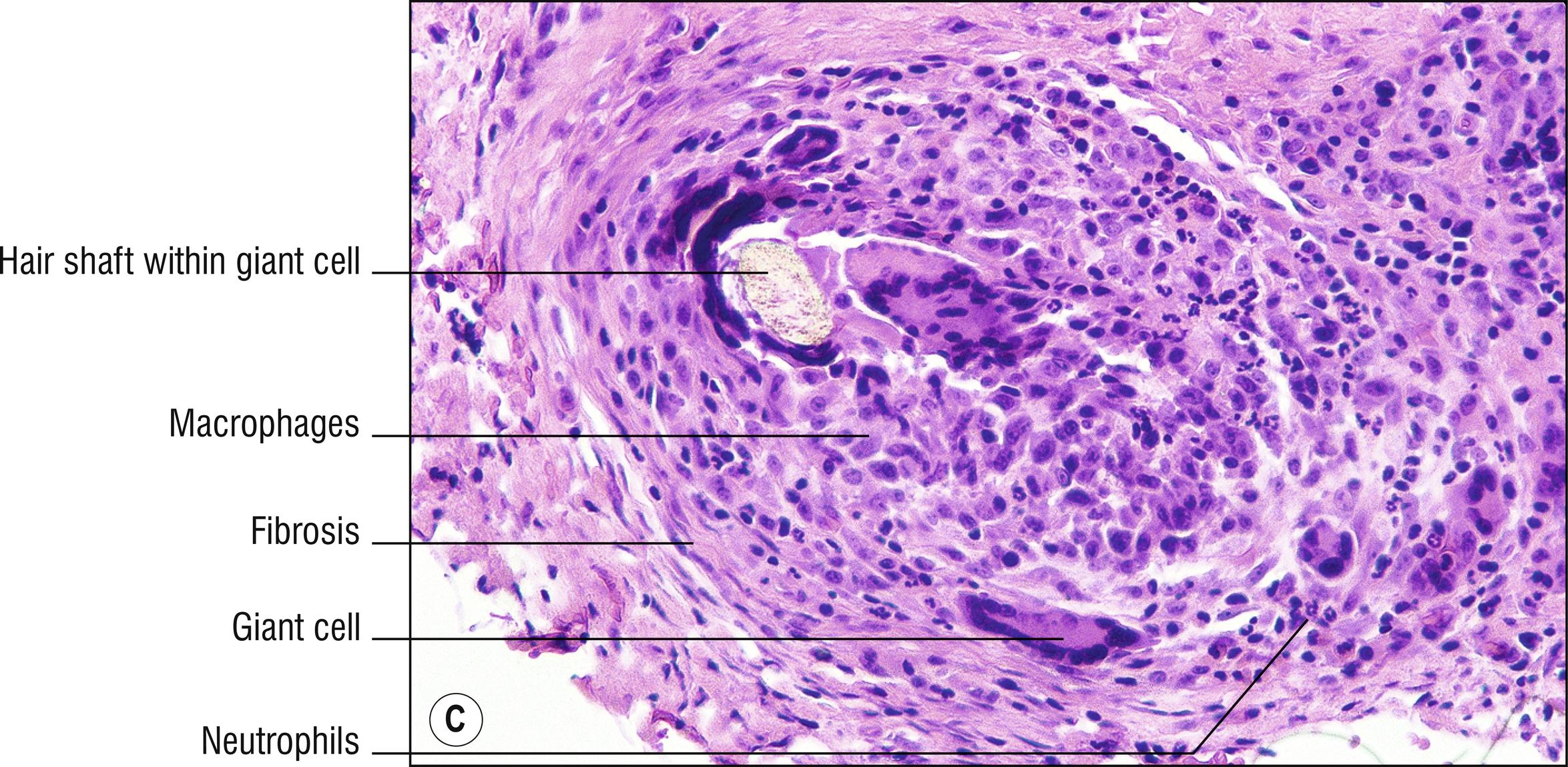
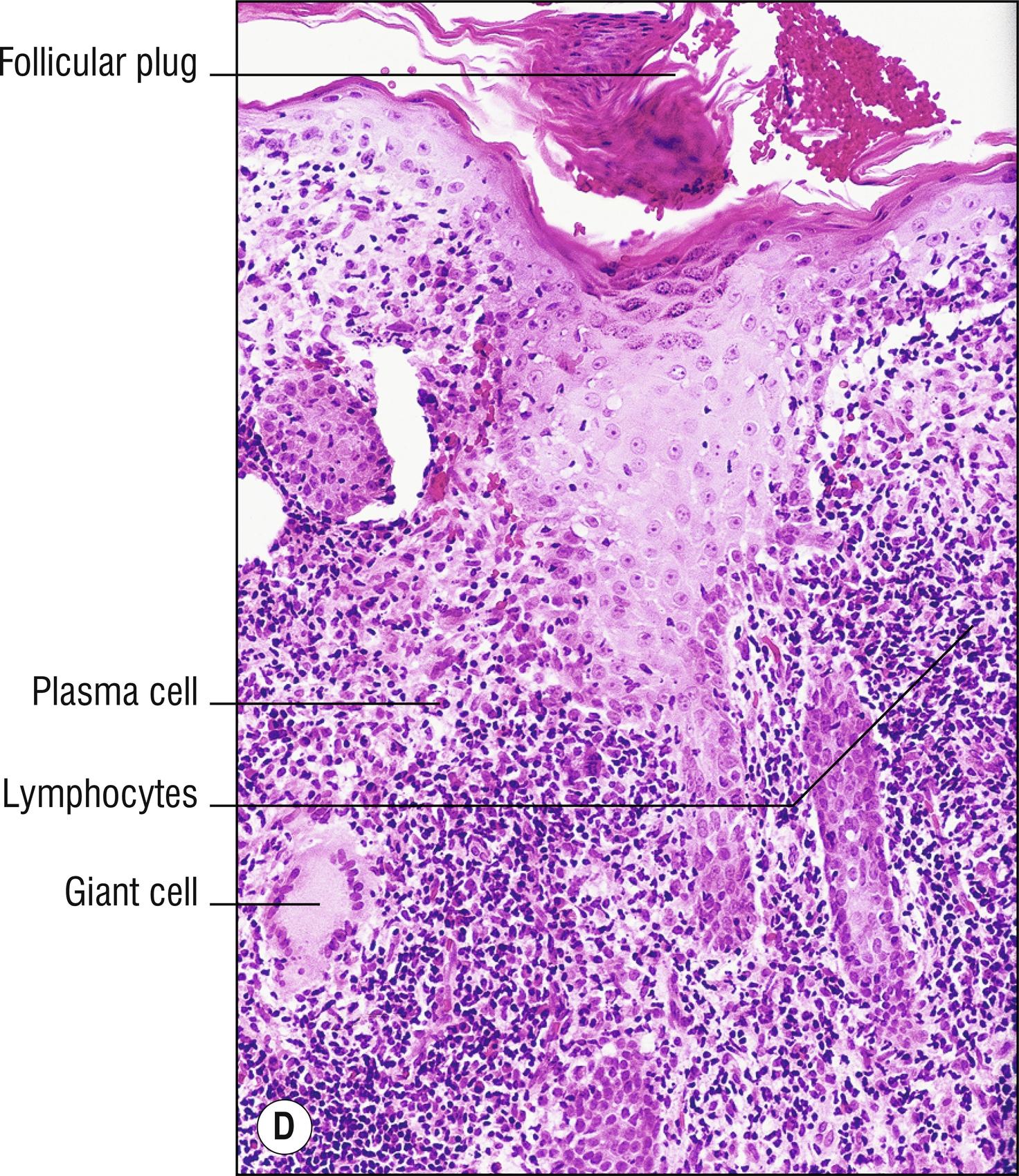
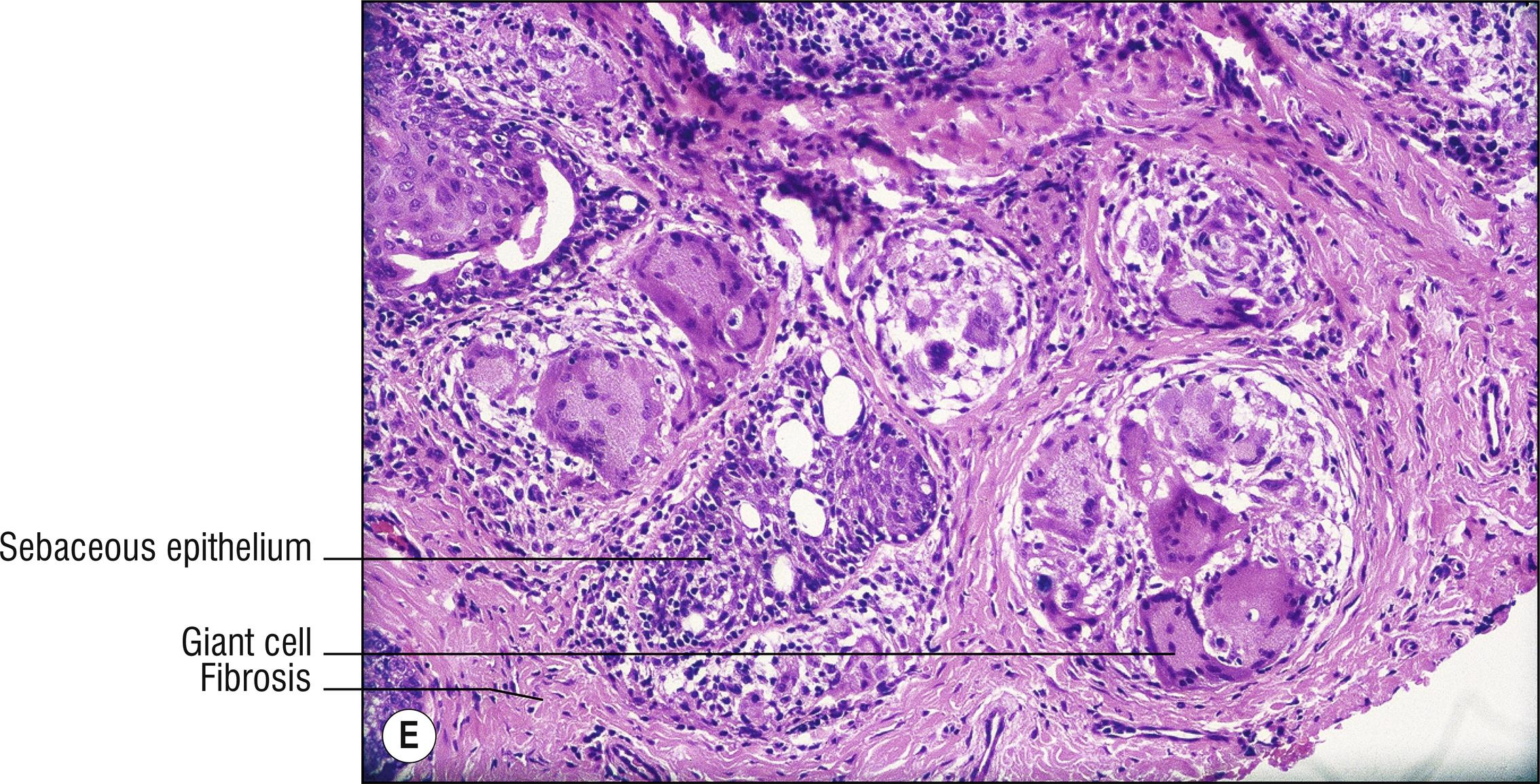
Very common disorder, open comedones (blackheads), closed comedones (whiteheads), red papules , pustules , cysts (ruptured inflamed sebaceous glands without an epithelial lining as in most “true cysts”; 1.25), and nodules. More in teenagers and young adults, more on face and trunk, related to increased keratinization of the infundibulum of the follicle, increased sebum production related to hormones, secondary normal flora bacterial overgrowth (especially certain strains of Cutibacterium acnes , formerly known as Propionibacterium acnes ), and inflammation related to bacterial products and lipids. Acne vulgaris is the prototype. The term vulgaris in the ancient dermatology literature (14.1) was often applied in this way, so that psoriasis vulgaris is standard plaque psoriasis, verruca vulgaris is the standard wart of the fingers, and lupus vulgaris was a standard type of tuberculosis seen on the face more commonly years ago.
Follicular plugging (1.47)
Sometimes intraepidermal pustules (1.89) overlying follicles, or within follicles
Frequently ruptured pilosebaceous apparatus with perifollicular mixed infiltrate of neutrophils, lymphocytes, plasma cells (1.111), histiocytes, and/or multinucleated giant cells (1.84)
Sometimes abscesses, sinus tracts, and fibrosis
Follicular occlusion triad: term used for the closely related diseases acne conglobata (nodulocystic acne of the face and trunk), folliculitis decalvans of the scalp ( perifolliculitis capitis abscedens et suffodiens , dissecting cellulitis of the scalp ; 10.2), and hidradenitis suppurativa (HS, acne inversa) of the axilla, inframammary, or groin areas (distribution like inverse psoriasis). Hidradenitis is really a follicular occlusion problem rather than an apocrine gland disease (despite synonym apocrinitis), as the apocrine glands drain into the follicles. The histology of all of these conditions is similar, with frequent abscesses, suppurative granulomas, and sinus tracts.
Rosacea: mainly in adults, with a telangiectatic type that is mostly macular erythema, with frequent flushing with exposure to heat, certain foods and other flare factors, and a true acne rosacea in which there are typical acneiform papules and pustules (but fewer comedones than acne vulgaris), more on the central face, sometimes producing blepharitis (ocular rosacea), sometimes producing sarcoidal or tuberculoid granulomas (granulomatous rosacea), rarely with caseation. Persisting papules of granulomatous rosacea (for 1 or 2 years or more) has also been called lupus miliaris disseminatus faciei or acne agminata because it resembles miliary tuberculosis. Rosacea, more than other forms of acne, have a relationship with Demodex mites (15.8) and Bacillus oleronius .
Erythema and edema of the face (solid facial edema, Morbihan’s disease): clinical form of severe acne in which there is impressive redness and swelling of the central face.
Chloracne: mostly comedones, less inflammation, mostly due to oils or chemical exposures.
Other clinical variants: drug-induced or aggravated acne may be due to steroids, lithium, phenytoin, iodides, and bromides. Acne fulminans is a severe form of nodulocystic acne most common in males, with fever, leukocytosis, proteinuria, arthritis, or osteolysis. There is the synovitis-acne-pustulosis-hyperostosis-osteitis (SAPHO ) syndrome, PAPA syndrome, and PASH syndrome (4.12) Acne mechanica is related to friction from hats, helmets, chin straps, etc. Neonatal acne is present in many normal newborns, often blamed on Pityrosporum yeast, resolving by 3 months of age.
Acne excoriee (including acne excoriee des jeunes filles, meaning more common in “young women”): prominent excoriations from picking acne lesions are dominant.
Perioral dermatitis and periocular dermatitis: acneiform lesions with coexisting eczema-like (dermatitis) changes, often due to or aggravated by topical steroid abuse, usually around the mouth or eyes.
Pyoderma faciale: severe form of nodulocystic acne of the face, more in females.
Familial dyskeratotic comedones: rare inherited condition with comedones (1.24) on the trunk, at the base of which is acantholytic dyskeratosis (1.2, 1.27).
Chalazion: red papule or nodule of the inner eyelid, with granulomatous inflammation around a Meibomian sebaceous gland. Sty and hordeolum are similar, but these terms are more commonly used for lesions of the cutaneous surface of the eyelid.
Pilonidal sinus or cyst: suppurative granulomatous reaction to follicular unit, with many hair shafts embedded in fibrosis, may become quite large, usually in hairy or obese adult males on the sacral area, resembles a ruptured cyst but has no epithelial lining, although sinus tracts may be present.
Other acneiform (1.3), follicular (1.47), or comedonal (1.24) diseases.
Other diseases with neutrophils (1.89).
Other granulomas (1.51).
(see Fig. 10.2A,B )
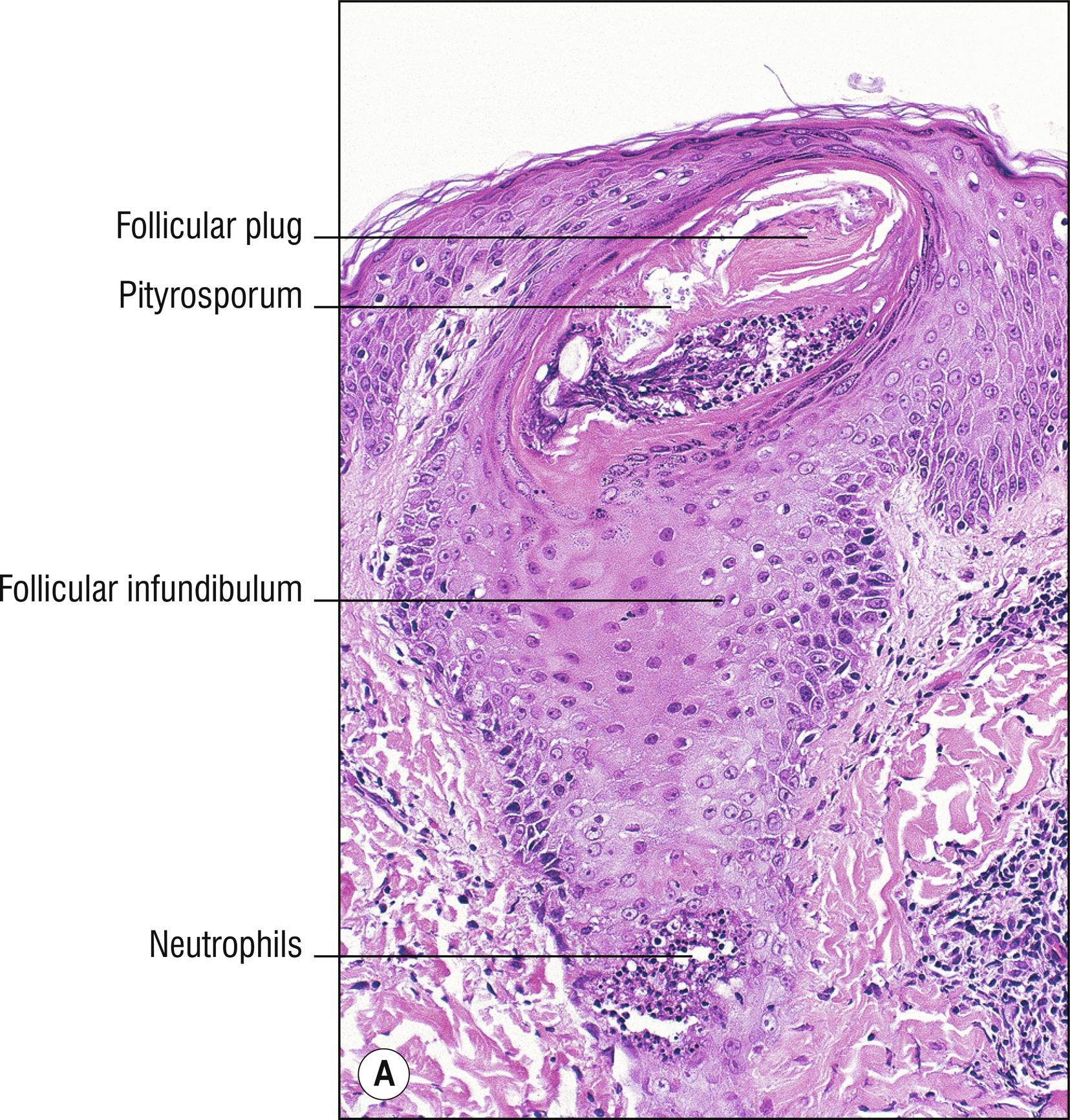
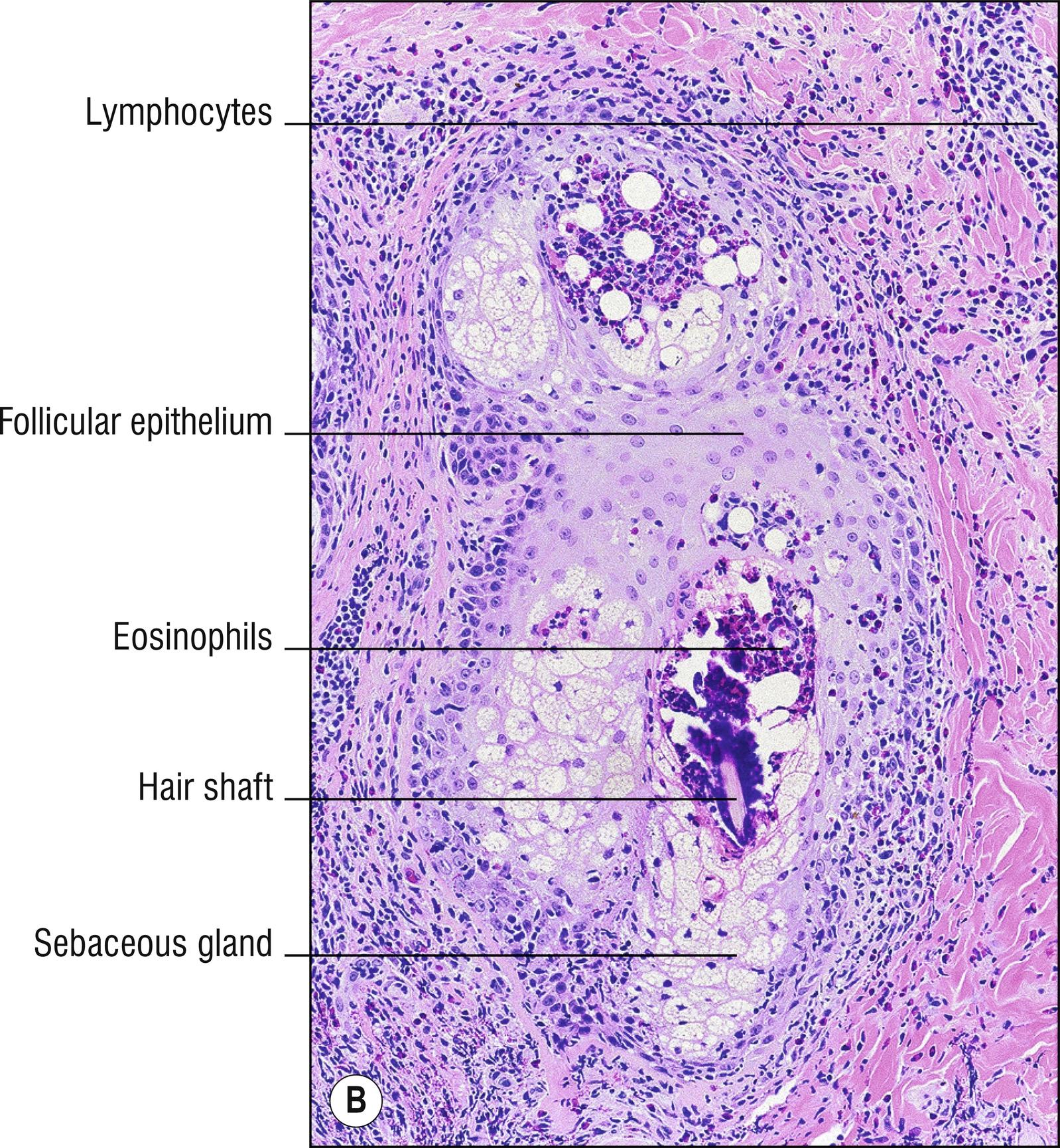
Common papulopustular eruption , especially on the scalp (1.124), trunk (1.141), and legs (1.67) of women from shaving irritation.
Perifollicular or intrafollicular mixed infiltrate of lymphocytes, histiocytes, or plasma cells, sometimes resulting in a ruptured follicle surrounded by neutrophils and multinucleated giant cells
Look for causative organisms: most folliculitis is due to follicular occlusion with normal flora, but some cases are due to Staphylococcus , Gram negatives (Gram-negative folliculitis, especially in patients on chronic antibiotics), Tinea (13.10), Candida (13.4), Malassezia ( Pityrosporum ), or Demodex (15.8)
Perifollicular fibrosis in older lesions
Pseudofolliculitis barbae (PFB): razor bumps from shaving the beard and neck (1.86), more in black skin, with inward-coiling hairs producing folliculitis (not really a “pseudo”).
Perifolliculitis capitis abscedens et suffodiens (dissecting cellulitis of the scalp): severe clinical disease , more in black skin, more abscess and sinus tract formation on scalp .
Folliculitis decalvans: deeper folliculitis on scalp , more common in black skin, which may progress to dissecting cellulitis.
Disseminate infundibulofolliculitis of Hitch and Lund: characteristic clinical appearance of multiple smooth papules resembling gooseflesh, mostly on the upper trunk in black skin , spongiosis and lymphocytes in superficial part (infundibulum) of follicle and sweat ducts. Compare with juxtaclavicular beaded lines (21.1), which is also common in same location in dark skin.
Eosinophilic pustular folliculitis (Ofuji’s disease): form of folliculitis in which papulopustules may become confluent into plaques, more common in HIV disease (14.12) or as a childhood scalp disorder, many eosinophils (1.36) in or around follicles along with lymphocytes.
Folliculitis keloidalis nuchae: posterior scalp and neck (“nuchae”), more in black skin, more scarring ( keloid formation; 27.2).
Hot tub folliculitis: due to Pseudomonas from exposure to hot tubs with inadequate bromine, self-limited.
Erosive pustulosis of the scalp: idiopathic condition with pustules, erosions of scalp.
Epidermal growth factor inhibitor (EGFRI) drug reaction. The drugs lapatinib, cetuximab, erlotinib, and panitumumab are used for solid tumors, often resulting in folliculitis.
Acne (10.1). The difference between acne and folliculitis is sometimes moot because the follicle and sebaceous gland are all part of a pilosebaceous unit.
Special stains and cultures can help to rule out bacterial or fungal folliculitis.
Other diseases with follicular plugging (1.47), neutrophils in the dermis (1.89), or granulomas (1.51).
Uncommon papular eruption with hyperkeratotic plugs or pustules in the center of lesions, distinguished from ordinary folliculitis by some authorities because of the rupture of the follicular walls, but this may not really be different than any other form of folliculitis (10.2).
Follicular plugging
Perforation of the follicle by degenerating elastic and collagen fibers
Perifollicular neutrophils (1.89), lymphocytes, or plasma cells (1.111) often
Other perforating diseases (1.140) or follicular diseases (1.47).
(see Fig. 10.4 )
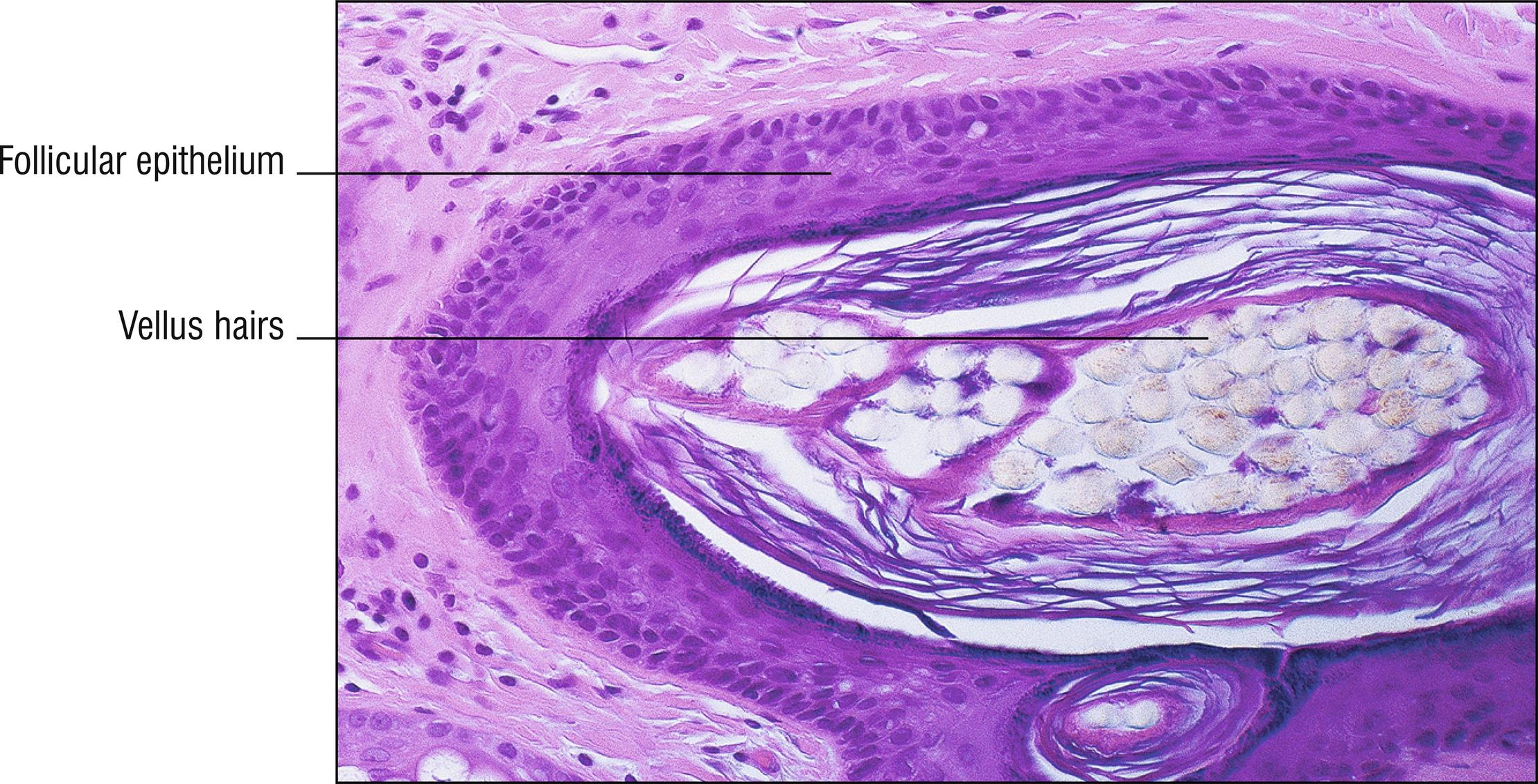
Common as an incidental histologic finding in some other lesion such as a melanocytic nevus, or presenting as multiple black open comedones (1.24), especially on the nose (1.95) or face (1.44), sometimes associated with acne (10.1).
Numerous vellus hairs within a follicle
Pili multigemini: terminal hairs are clumped within a follicle instead of vellus hairs, arising from multiple divisions within the hair matrix, or several hair papillae may converge into one follicle, most common on the beard of males. Hairs may adhere to one another, then become separate, then adhere again (pili bifurcati). Compound hairs, where two or three hairs come forth from a follicle, is similar, considered to be normal on the occipital scalp.
Tufted hair or tufted folliculitis (polytrichia, doll’s hair deformity) occurs in cicatricial alopecia, where inflammation damages a follicle or multiple adjacent follicles so that multiple hairs come out of one orifice.
(see Fig. 10.5 )
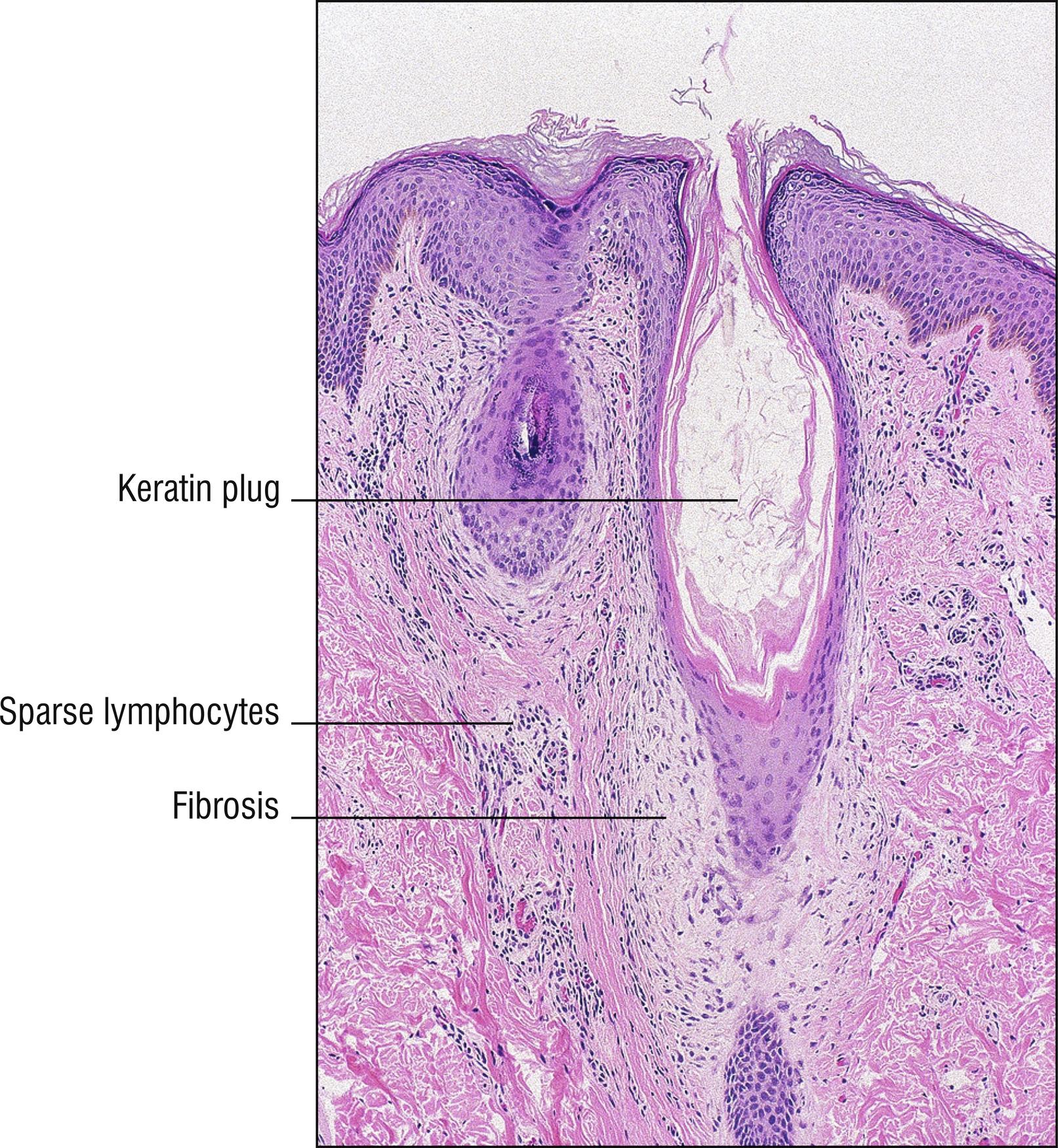
Keratosis pilaris is a common eruption of spiny follicular papules , especially on the lateral arms and anterior thighs of children and young adults. Lichen spinulosus appears as a localized plaque of grouped spiny papules, mostly on the trunk, found in the same age group. Both conditions are associated with atopic dermatitis (2.1).
Follicular plugging
Sparse perifollicular lymphocytes or neutrophils sometimes
Become a Clinical Tree membership for Full access and enjoy Unlimited articles
If you are a member. Log in here